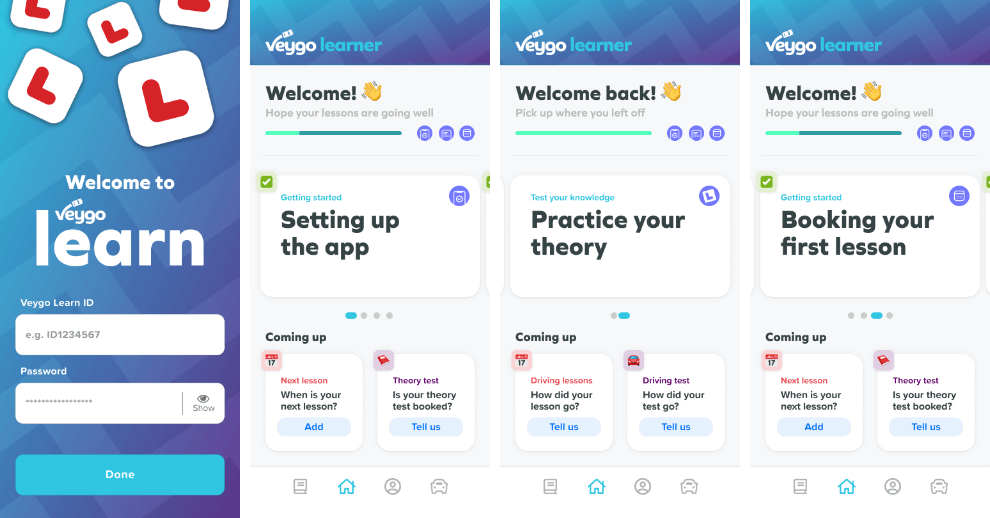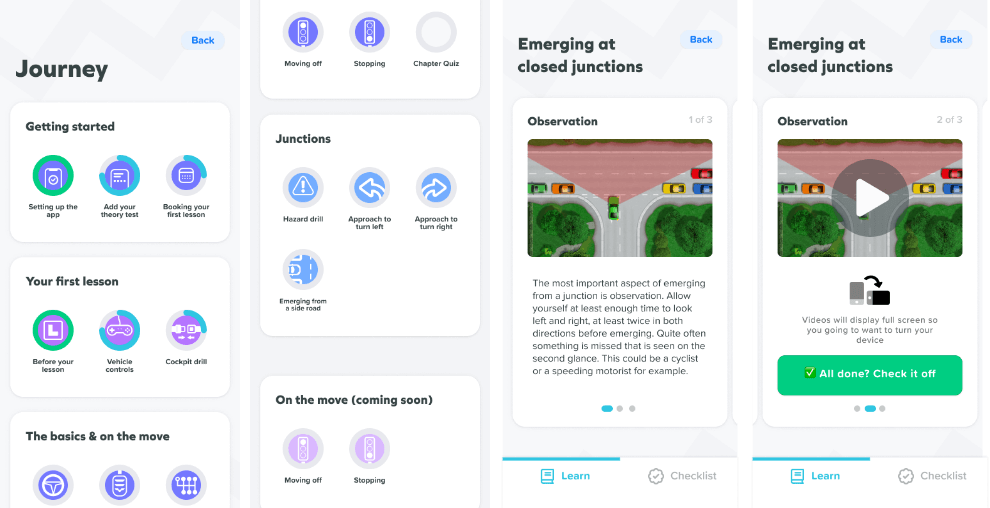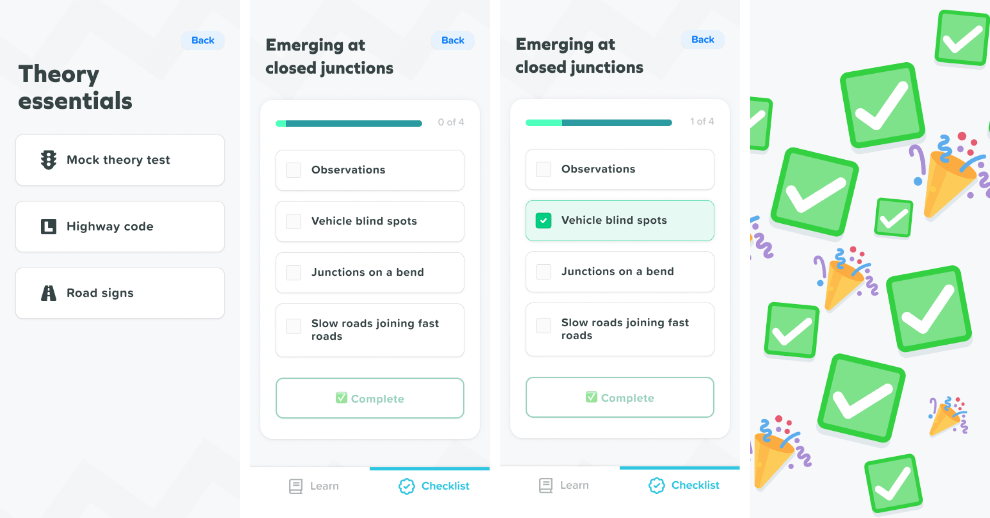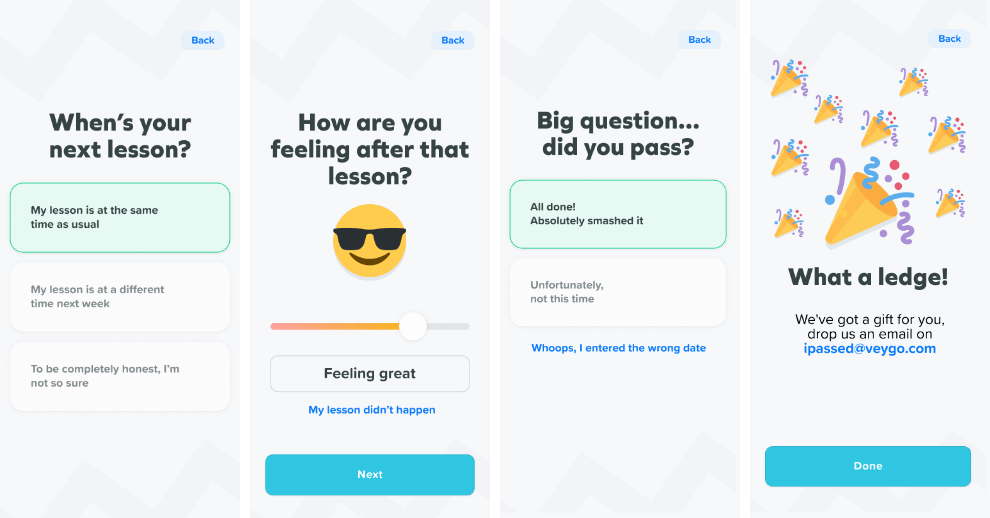The Challenge:
To deliver a mobile app MVP in 4 - 6 weeks.
Services provided
Tech Stack
Recommendation
Support
in idea validation
About Veygo and Admiral
Need to borrow a friend or family member’s car?
Just bought a car and need to drive home?
Veygo is a temporary car insurance company that enables you to easily activate car insurance in minutes. You can get it instantly, no matter if you need it for a few hours, a day, a week. However you like it, from 1 hour to 30 days.
Veygo is also a part of Admiral Group - one of the top and leading car insurance companies in the UK. In fact, voted Best Car Insurance Provider seven years in a row!
Veygo Mission
“To give people everything they need to pass their test first time, in the fastest and safest way”
Who doesn’t have their own car yet, and is willing to borrow it from a family member, or a friend?
Or who wants to buy a car and needs to get it home from the seller, without any complicated insurance papers?
Exactly! People that just got their driving license!
So the idea was as follows:
“to help learner drivers with one of the “jobs” in learning to drive by giving them a flexible way to practice, outside of formal lessons, in a parent / family member’s car whilst protecting the owner’s insurance.”
There are still 4 other main jobs:
- formal practice,
- theory test,
- practical test,
- developing confidence,
And Veygo’s vision was to support fresh drivers with the whole journey, by giving them everything they need to pass the first time test, all in one simple app.
Why build the MVP?
You might already know that one of the reasons why startups fail is the lack of product-market fit.
And building a Minimum Viable Product (MVP) is a great way to build not only web and mobile apps, but also digital business around them with relatively small risk (or highly efficient risk mitigation).
Building an MVP is also close to the iteration cycle, which means that you take the core functionality of your app, and you arrive at the market without any additional functionalities to get as much feedback from users as possible and adapt to it.
This way, you don’t have to spend too much investment on things that are not needed at the beginning, as well as you won’t get too attached to the idea if it’s not going to work out.
One of the main benefits of using the MVP approach is that you can immediately get wonderful feedback straight from the users and validate your idea quite easily.
And that’s exactly the goal Veygo had in mind.
To find out more on how to build an MVP, check the video below:
Plan of Action
Building a new business line is a heck of a responsibility, and Veygo's new team had to deal with many expectations from different stakeholders, like CEO, CFO, CMO, etc.
They were now responsible for taking the product from concept to market, so they worked out the concept together with the plan of action, assembled the internal team, and was ready to find a technical partner to help them build the MVP.
Questions remained:
- What exactly can we expect from a tech partner?
- Which technology will be the most efficient?
Choosing Technology Partner
In general, it’s really helpful to find someone who is able to understand your business and strategy objectives.
It’s also great if the partner is able to translate those objectives into technical requirements in a clear and easy-to-understand way.
This is why Veygo decided to use the help of external tech consultant to help them find the right resources.
In short, they wanted “to deliver a good quality MVP in 4-6 weeks”.
As Hannah explained in her Clutch review, one of the deciding factors was clarity.
“We reached out to 2–3 development companies, but we were really struck by how Pagepro was able to keep things simple while still explaining to us how they would deliver the idea that we had.
They checked all the boxes and also were very affordable — for us, it just made perfect sense to work with them.”
Veygo’s top deciding factors while choosing an agency:
Simplicity in communication
Ability to work with tight deadline
Work ethic and quality assurance
Cost-efficient
Choosing the right technology: Native vs PWA vs React Native
While gathering the initial requirements, we also took part in the process of choosing the right technology.
There were three different technologies on the table:
- Native Development
- Progressive Web App (PWA)
- Cross-platform App (React Native)
We went through all the proposals, starting from the main criteria: time to market.
"Guys, if you got 4-6 weeks, what’s doable?"
Why not Native Development?
Veygo believes that if you put a shorter deadline on delivery, you will have to shrink the functionalities to the absolute minimum, and that’s exactly what they wanted.
All they need the prototype for, is to check the assumptions, and the MVP concept was perfectly enough to do so. If the feedback doesn't fit the assumptions, they won’t be going further with the development.
However, native development didn’t appear to be the fastest, nor the cheapest way to build the MVP, especially if you want to launch the app on both iOS and Android platforms.
On top of that, they were ready to abandon the idea, if it didn’t meet the market fit, so native development seemed to be too much time and cost consuming for such an initiative.
Why not a Progressive Web App (PWA)?
As an alternative, they were considering using Progressive Web App (PWA) development.
“We need a simple advice, like: these things are really complicated, and these things are not, so that we can weight specific functionalities and prioritise"
And as we started talking about functionalities we found that one of the most important functionalities are push notifications.
Unfortunately, with PWA you cannot have the iOS push notifications. Even more, you cannot publish a PWA app on the AppStore.
The winner: Cross-platform approach with React Native
So, in summary, to:
- keep the short development time,
- get to market faster,
- get the most important functionalities working,
- be on both App Store and Google Play,
- and make a quality MVP that we can easily reuse in the final product,
React Native appeared to be an ultimate, and a perfect solution.
 |  |  | |
|---|---|---|---|
| Native Development | PWA | CROSS-PLATFORM (with React Native) | |
| Pros |
|
|
|
| Cons |
|
|
|
| Verdict | Since the MVP doesn’t require, nor contain any heavy functionalities the cost of hiring native developer ( or two to appear on both platforms) and future cost of maintaining, as well as speed of implementing new features - the native approach is mismatched. | Because of lacking core features like push notifications a PWA approach was also a mismatch. | The MVP is a perfect use case for React Native. Thanks to React Native we could achieve all current and future project objectives in a shorter time, as well as it appeared to be much more cost-efficient choice. |
The MVP development process
Type of product
MVP
Time
4 - 6 weeks
Technology
React Native
Priority
Time to market
Gathering requirements
Veygo’s business requirements:
- Time To Market (4-6 weeks to build crucial functionalities)
- Idea Validation (check the assumptions)
- Recognize Market Signals (uncover needs and potential opportunities)
- Risk Mitigation (Minimize financial loss if we decide to abandon the idea)
MVP functional objectives:
- Track learning progress
- Schedule lessons/practice/tests
- Send push notifications with reminders about upcoming lessons, important dates,etc.
- Display content in an attractive form.
MVP functional requirements:
- The ability to track each customer event to understand which features they engage with most and least
- The ability to upload and link educational material such as articles and videos
- The ability to serve third party educational material within the app (e.g. Youtube videos)
- The ability to capture customer data as they tell us more about their learning to drive journey and store it in places such as Mailchimp (for customer email)
- Each customer must agree to the privacy policy statement before they give us any data and we should have a record to show that they have
- The ability to push scheduled messages / notifications to customers based on the lesson dates they give us
- Record of notification settings chosen (at user level) that we can access and see
- The ability to trigger and serve rewards (like discount codes)
- The ability to save customer progress locally (for them) and externally (for us)
- The ability to tailor and serve content relative to the customer’s progress
Technologies used in MVP development
- React Native & Expo
- TypeScript
- Firebase
- Styled Components
- Node JS
- Sanity Headless CMS
Should we get it done?
Let's talk about you now!
Tell us about your challenge, and let's get the ball rolling.
The outcome
After a few weeks of ork, we’ve arrived with the MVP, ready to test the assumptions.




Test the assumptions
There were quite a few assumptions that Veygo wanted to check:
- Are people willing to tell us about their journey?
- Can we analyse the data they give us?
- Can we tailor content in a meaningful way?
- Does our app fit into the traditional learning to drive journey?
- Do learners want to track their progress?
Quite unexpectedly, before Veygo even checked all the assumptions, they were already quite sure that the app was a great idea.
They were able to acquire enough happy users to recognize the potential, and this is why (just after a few weeks) they decided to move into further development.
Quote from a client:
“That’s an underrated skill that Pagepro has. They are able to simplify things. They’ve been quick, and they always deliver at the end of each two-week sprint. On top of that, the quality was excellent from the first time.”
Have a similar case? Use our experience!
Talk to our expert and see what we can to do push your project further.









